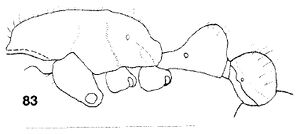Chelaner macarthuri
| Chelaner macarthuri | |
|---|---|
| Scientific classification | |
| Kingdom: | Animalia |
| Phylum: | Arthropoda |
| Class: | Insecta |
| Order: | Hymenoptera |
| Family: | Formicidae |
| Subfamily: | Myrmicinae |
| Tribe: | Solenopsidini |
| Genus: | Chelaner |
| Species group: | rubriceps |
| Species: | C. macarthuri |
| Binomial name | |
| Chelaner macarthuri (Heterick, 2001) | |
Known only from three workers from two widely separated collections. The Poochera specimen was taken in a pitfall trap [A. McArthur, personal communication].
Identification
Heterick (2001) - A member of the rubriceps group. Chelaner macarthuri is an attractive species characterised by an unusually large, round postpetiole. This condition is normally associated with the genus Cardiocondyla, and is not found in any other Australian Chelaner.
Keys including this Species
Distribution
Latitudinal Distribution Pattern
Latitudinal Range: -32.75° to -34.48333333°.
| North Temperate |
North Subtropical |
Tropical | South Subtropical |
South Temperate |
- Source: AntMaps
Distribution based on Regional Taxon Lists
Australasian Region: Australia (type locality).
Distribution based on AntMaps
Distribution based on AntWeb specimens
Check data from AntWeb
Countries Occupied
| Number of countries occupied by this species based on AntWiki Regional Taxon Lists. In general, fewer countries occupied indicates a narrower range, while more countries indicates a more widespread species. |

|
Estimated Abundance
| Relative abundance based on number of AntMaps records per species (this species within the purple bar). Fewer records (to the left) indicates a less abundant/encountered species while more records (to the right) indicates more abundant/encountered species. |

|
Biology
Castes
Worker
 
| |
| . | |
Nomenclature
The following information is derived from Barry Bolton's Online Catalogue of the Ants of the World.
- macarthuri. Monomorium macarthuri Heterick, 2001: 432, figs. 48, 82, 83 (w.) AUSTRALIA (South Australia).
- Type-material: holotype worker, 2 paratype workers.
- Type-locality: holotype Australia: South Australia, Maggea, 25.ix.1974 (P.J.M. Greenslade); paratypes: 1 worker with same data, 1 worker South Australia, Poochera, 32°45’S, 134°50’E (no collector’s name).
- Type-depositories: ANIC (holotype); ANIC, MCZC (paratypes).
- Combination in Chelaner: Sparks, et al. 2019: 233.
- Status as species: Sparks, et al. 2019: 233.
- Distribution: Australia.
Unless otherwise noted the text for the remainder of this section is reported from the publication that includes the original description.
Description
Worker
Holotype. HML 2.05; HL 0.74; HW 0.60; CeI 81; SL 0.54; SI 90; PW 0.47. Others. HML 1.95-2.02; HL 0.64; HW 0.52; Cel 80; SL 0.46-0.47; SI 89-91; PW 0.41-0.43 (2 measured).
As for the worker of Chelaner longiceps, but with the following apomorphies.
Head. Frons of head capsule smooth and shining with scattered foveae and striolae, pilosity combination of incurved decumbent and subdecumbent setulae and erect and suberect setae. Compound eyes elliptical; (viewed laterally) compound eyes set posterior of midline of head capsule. Anteromedial clypeal margin straight or slightly emarginate, median clypeal carinae not produced as teeth or denticles. Frontal lobes parallel, sinuate. Mandibles (viewed from front) triangular and smooth, with piliferous punctures.
Alitrunk. Promesonotal sculpture present in form of scattered foveae and striolae, mainly on the mesopleuron, and mesopleural striae. Mesonotal suture absent. Metanotal groove present as feebly impressed furrow between promesonotum and propodeum. Dorsal propodeal face strongly convex; processes absent (propodeum smoothly rounded in profile or with slight hump at propodeal angle). Propodeal angle absent. Erect and suberect propodeal setae 5-10.
Petiole and postpetiole. Petiolar node cuboidal. Height ratio of petiole to postpetiole near 3:4 to near 1:1. Sculpture present in form of microreticulation. Ventral process vestigial.
General characters. Colour alitrunk, petiole and postpetiole reddish-orange, head, gaster and appendages gamboge yellow. Worker caste monomorphic.
Type Material
Holotype. 1 worker, South Australia, Maggea, 25.ix.1974, P. J. M. Greenslade (Australian National Insect Collection). Paratypes. South Australia: 1 worker with same data as the holotype (ANIC); 1 worker, Poochera 32°45'S, 134°50'E, SAM Notho [Nothomyrmecia] search (Museum of Comparative Zoology).
- Holotype, worker, Maggea, South Australia, Australia, Greenslade,P.J.M., ANIC32-015664, Australian National Insect Collection.
- Paratype, 1 worker, Maggea, South Australia, Australia, Australian National Insect Collection.
- Paratype, 1 worker, Poochera, 32°45’S 134°50’E, South Australia, Australia, 32°45′0″S 134°50′0″E / 32.75°S 134.833333°E, Museum of Comparative Zoology.
Etymology
Named in honour of Mr. A. J. McArthur, of the South Australian Museum.
References
- Sparks, K. 2015. Australian Monomorium: Systematics and species delimitation with a focus of the M. rothsteini complex. Ph.D. thesis, University of Adelaide.
- Heterick, B. E. 2001. Revision of the Australian ants of the genus Monomorium (Hymenoptera: Formicidae). Invertebrate Taxonomy. 15:353-459. (page 432, figs. 48, 82, 83 worker described)
- Sparks, K.S., Andersen, A.N., Austin, A.D. 2019. A multi-gene phylogeny of Australian Monomorium Mayr (Hymenoptera : Formicidae) results in reinterpretation of the genus and resurrection of Chelaner Emery. Invertebrate Systematics 33: 225–236 (doi:10.1071/IS16080).
References based on Global Ant Biodiversity Informatics
- Heterick B. E. 2001. Revision of the Australian ants of the genus Monomorium (Hymenoptera: Formicidae). Invertebrate Taxonomy 15: 353-459.